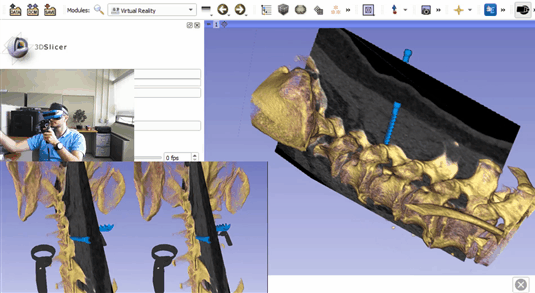3D Slicer 4.10 gets Released with Improved Rendering Performances and New Virtual Reality Support

3D Slicer is a free, open source, extensible application for visualization and image analysis. It is widely used in the field of medical computing, with over 425,000 downloads. In the field, 3D Slicer is applied to research and applications that range from preclinical animal studies to surgical planning, to surgical guidance, to medical robot control, to 3D printing, to population studies.
3D Slicer is made possible through contributions from an international community of scientists from a multitude of fields, including engineering and biomedicine. The authors of this blog are the Kitware team which participated in the wider community that made this release happen.
On behalf of the 3D Slicer development community, we are pleased to announce that version 4.10 is now available for download. This version introduces close to 500 feature enhancements and bug fixes for better performance and stability. It includes more than 20 new-and-improved core modules and more than 25 new-and-improved extensions.

Here are some release highlights:
- A new rendering infrastructure can more quickly rendering complex models. In addition, GPU-accelerated volume rendering works on many more hardware configurations than before. It is also faster and higher quality. The minimum required OpenGL version is now 3.2.
- Threaded Building Blocks (TBB) is now available as a SMP backend in VTK. It is enabled by default on Windows. Multi-threaded image filter execution is typically improved by 20-30%.
- For more details, read the Performances section in the Changelog.
- New Segmentation effects and features include the following:
- Save segmentations directly to STL or OBJ files.
- Set different resolutions for the segmentation internal labelmap and the master volume. The labelmap can be set to a higher resolution, isotropic, etc. To do so, click the box icon next to the master volume selector.
- Automatically detect if slice views are not aligned to internal labelmap volume’s axes and allow alignment by clicking the warning icon that appears next to the segmentation node selector.
- Create hollow objects.
- Apply tube segmentation for needle trajectories or other tubular objects (in the SegmentEditorExtraEffects extension).
- Jupyter notebooks are available in 3D Slicer. They can be launched directly in any web browser, without installing 3D Slicer. Try now!
- 3D Slicer scenes can be viewed in any OpenVR-compatible virtual reality headset (e.g., HTC Vive, Windows MR headsets, Oculus Rift). 3D Slicer supports all rendering modes as regular desktop views, including 4D volume rendering. It is a great alternative to 3D printing.
- Charting capabilities have improved with the new Plots module.
- 3D Slicer now has experimental support for multi-volume volume rendering.
- There is a new template for building custom applications based on 3D Slicer. This template is used in several custom clinical software applications and research tools, such as SlicerSALT.
Please visit the 3D Slicer forum for a complete list of improvements and fixes.
The development of 3D Slicer—including its numerous modules, extensions, datasets, pull requests, patches, issues reports, suggestions—is made possible by users, developers, contributors and commercial partners around the world. This development is funded by various grants and agencies. For more details, please see the 3D Slicer Acknowledgments page.
We are one of the lead maintainers of 3D Slicer and other software solutions such as the Insight Segmentation and Registration Toolkit (ITK), the Visualization Toolkit (VTK) and CMake. To support these solutions, we offer consulting services. Contact us at kitware@kitware.com to learn how we can help integrate the software into your research, products and processes.